|
CHAPTER 6 - MULTI-POSITION MOTORCYCLE DESIGN |
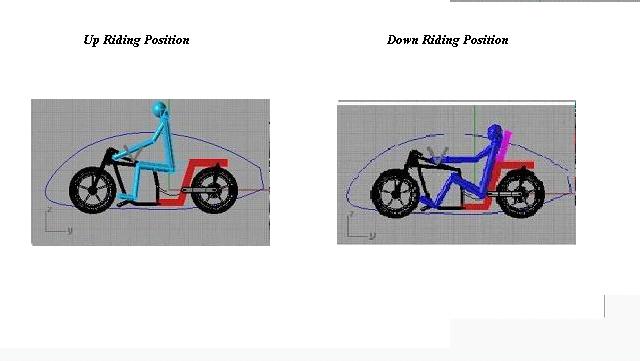 The racing tuck is the best aerodynamic position for my Dustbin Motorcycle. But, there is a fundamental problem with this seating position. It is very uncomfortable for longer rides and the view sucks! I enjoy riding a motorcycle because I like the view. I like to be IN nature; the wind in my face, breathing the air, feeling the sunlight on my body, being in the outdoors with nothing between me and the environment - a silent electric motorcycle makes this experience just that much better. Being crouched over with my belly touching the seat and my neck all kinked up barely able to see over the fairing ruins the experience. So, I need to start over. Here is the next chapter of my Motorcycle journey; A multi-riding position design. My concept has the comfortable reclined rider position (like the Dan Gurney Alligator Motorcycle). But, I also retain the ability ride in a more upright position for safety, and I'm adding a third wheel for low speed stability so I can fully enclose the bike with a streamliner shell when I am done. In my concept, the seat is a like a trap door that falls away or rises up to allow quickly changing ride position while driving down the road VINTAGE 1982 The General Motors Lean Machine Concept Car
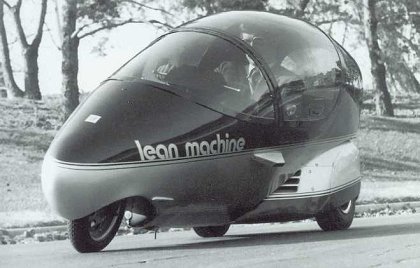 The Tilting trike is not new (e.g. Honda Gyro, GM Lean Machine). The front of the vehicle tilts just like a conventional motorcycle, but at slow speeds and at a full stop, the vehicle can be locked upright making for easy load and unload. Also, the underside of the vehicle can be completely enclosed; greatly improving aerodynamic efficiency and improving wet weather rides. The two rear wheels offer distinct advantages for traction, stability, cargo and fuel capacity (extra batteries and or gas generator). One rider in DOWN Position 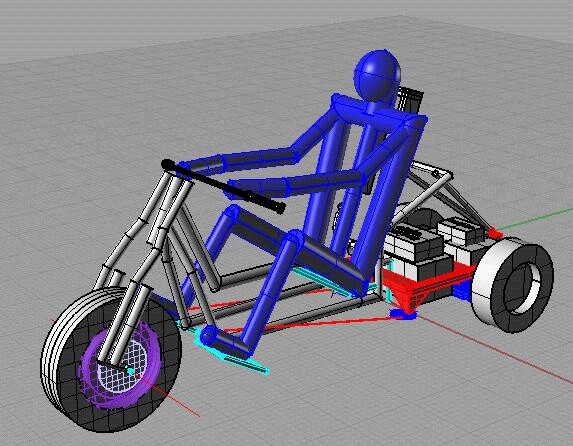 One rider in UP Position 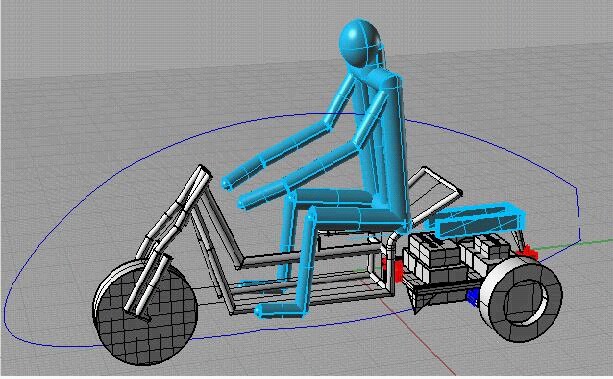 Two Riders in the UP Position 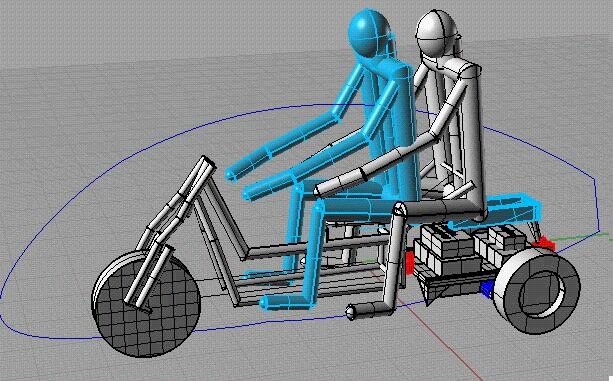 |
|
Question: Why have mulit-positions? Answer: Aerodynamics, Comfort, and Safety. AERODYNAMICS: Reducing air drag requires two things: 1. minimizing frontal and surface area 2. providing smooth air flow. By getting the rider inside the bike, frontal area can be reduced and cost of fairing can be reduced (less material, less weight). COMFORT: The racing crouch has been the historic way to reduce frontal area. It naturally gives a more stable position for agressive control of the bike and reduces air drag. Unfortunately, it comes at the cost of comfort and the ability to enjoy the view. A reclined seating position (a more car-like driving position) is nice but greatly increases frontal area IF the rider is perched on top of the bike. But, what if the rider were able to move INSIDE of the bike? This has always been hard to achieve because the engine is normally in the way. But, this year, electric hub motors INSIDE the wheel have become available for motorcycles - changing everything. SAFETY: Too low of a riding position hurts visability (your ability to see and be seen) which is a MAJOR safety issue on a motorcycle. Retaining an upright riding position for the times when it is needed is key to retaining safety. Riding in town, at intersections, in traffic, in hilly terrain, all benefit from a higher riding position. But, out in the country, a nice reclined riding position is more comfortable and more efficient. Here is a picture of my concept super-imposed on Craig Vetter's proto-type freedom machine. My shell can be smaller because of my lower reclined position. Please note the picture below shows the same rider in two different positions, NOT one rider sitting on a passengers lap. Super-Imposed on Craig Vetters Proto-Type 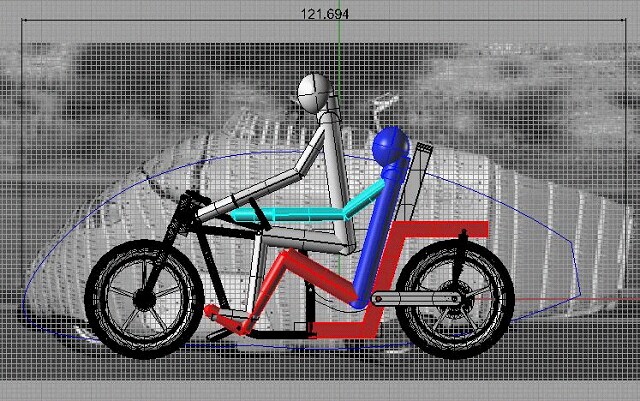 |
So, how do combine all the things I love into one vehicle? Let me list what I am looking for in a bike.
|
|
THE MOTOR Oct. 1, 2009 I picked up a scratch and dent 4,500 watt hub motor (approx 6.0 Hp) from Current Motors near Ann Arbor this week. The scooter these hub motors are normally installed in achieve 60-65mph max speed. They are into production on their electric scooters. They have an assembly line setup and had at least 10 scooters (with more in boxes) lined up getting built up. It was quite impressive. Way to go John! This hub motor can also be purchased from Kelly. I would have used the hub motor from Enertrac Enertrac (http://www.doingitall.net/EnerTrac/) because it has more power, top speed and is probably a better motor (efficiency-wise), but this hub motor is much smaller diamater (better for fitting into an aero shell), it has enough power for my proto-type and the price was unbeatable for a prototype... Here is hub motor with a 120/70-13 Kendra 413 tire on it. Notice the Sparrow Bicycle Hub Motor next to it and the 12 inch long ruler sitting on the face of it. This motor is a BEAST! The entire hub motor wheel assembly weighs 47 pounds (just the tire weighs 8 pounds). Its outside diameter with rubber on is about 19.5 inches. Next task is to fit it inside the helix forks.  |
|
THE FRAME Oct. 1, 2009 I did some searching and found the legendary motorcycle junk yard south of Lansing. Slicks Salvage in Mason, Michigan has a huge, well cataloged and organized selection of motorcycles and snowmobiles (and some watercraft) in several warehouses. At Slicks, I picked up a 1996 Honda Helix CN250 frame with front fork and brake assembly. The challenge with mounting a hub motor in the front wheel is that it is so wide (the hub motor is 200mm wide because it is normally mounted in the rear of the bike). But, the Helix modular trailing link fork design will help me, because I can make new trailing link arms that are offset to allow for a wider front wheel. Here are some cool pictures of the Honda Helix on the day it arrived at Slicks. Evidently, it slid a ways on one side on one of it's last rides. Personally, I'd say the crash improved it's look. Like a saying I saw on a tee-shirt once, SCARS ARE LIKE TATOOS...ONLY WITH BETTER STORIES. Normal Side 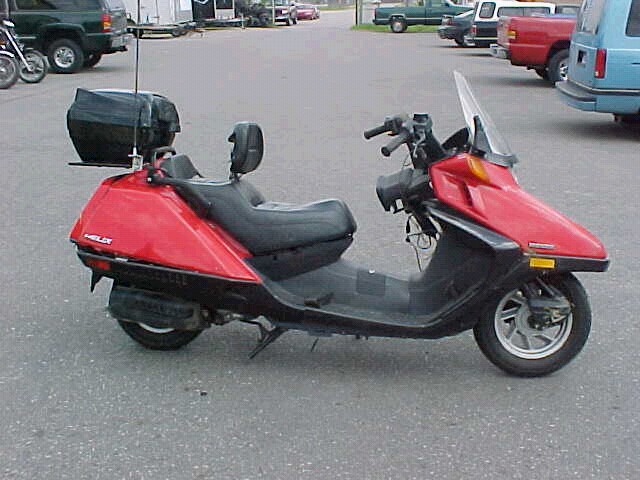 Customized Side 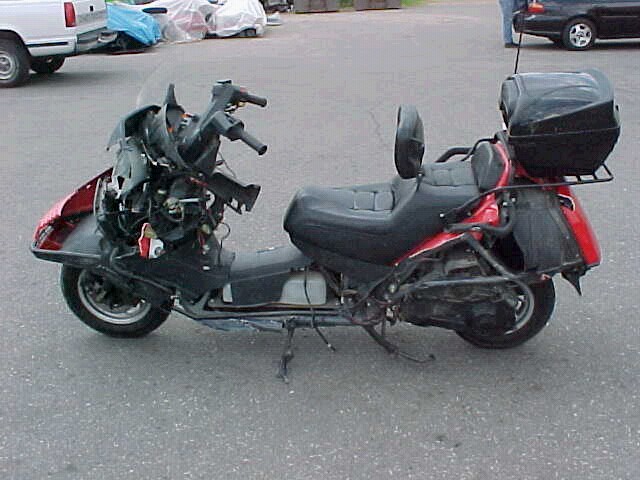 How I found Her  |
|
THE CONTROLLER Dec. 2, 2009 I found a Kelly KEB72451 Brushless controller, used on E-Bay. This is a 150A peak and 75A continuous, 72Volt controller. 72V x 75A = 5,184 watts / 746watt/Hp = 7Hp continuous and 14Hp peak. |
|
THE BATTERIES Dec. 3, 2009 I spent another afternoon looking at batteries. For a 72Volt system and my set-up a 40Ah a LiFePO4 battery pack would be just adequate especially if I can get a decent Super Capacitor to charge with Regen and not shock the batteries hard on take-off. A Thundersky LiFePO4 40Ah Setup with BMS and charger from EV Components would set me back around $2,600. A Headway LiFePO4 40Ah setup would set me back about $3,200. LiFePO4 are about one half the weight and have 5 to 10 times the recharge life (1,000-2,000 recharge cycles vs. 100-300 for Lead Acid). So, in the long run, LiFePO4 are a better value than Lead Acid batteries. The battery cost per mile is more like $.03/mile where as Lead Acid are $.10/Mile. A good LiFePO4 pack sized right should last 50,000 miles! This is great for a production bike, but I'm testing proto-types. Since, I have some lead acid batteries and chargers sitting around that I can use to test drive the vehicle, I think my $3,000 might be better invested building an aerodynamic shell. And the cost of batteries (other than the Lithium Shortage) should plummet in the next few years. |
|
FRONT WHEEL DRIVE (December 3, 2009) While it doesn't look like much, making a Hub motor designed to be a rear wheel fit inside the front forks is quite a challenge. There are many things to be gained by putting the motor in the front wheel (Front Wheel drive, more mass at the nose, very little mass in the tilting portion of the bike but relatively a LOT in the Spinning gyro making it more stable in cross winds). With some slight modifications I was able to fit the Hub Motor into the Honda Helix fork. Hub Motor In Honda Helix Fork 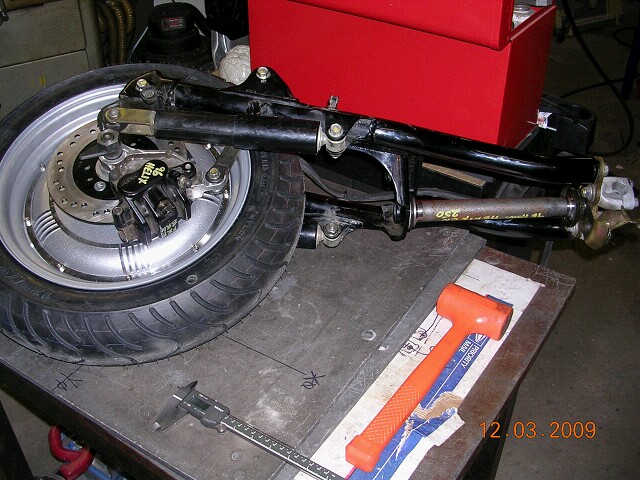 |
|
CHOP SHOP (December 4, 2009) Nothing like a Saws All when it comes to giving a Maxi Scooter a new look. Frame Chopped 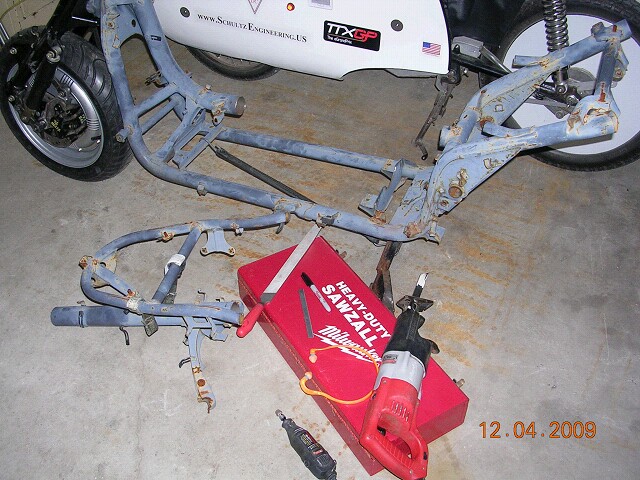 |
|
FIRST TEST SITTING December 4, 2009 Here are pictures to compare ride positions Tucked for Comparison 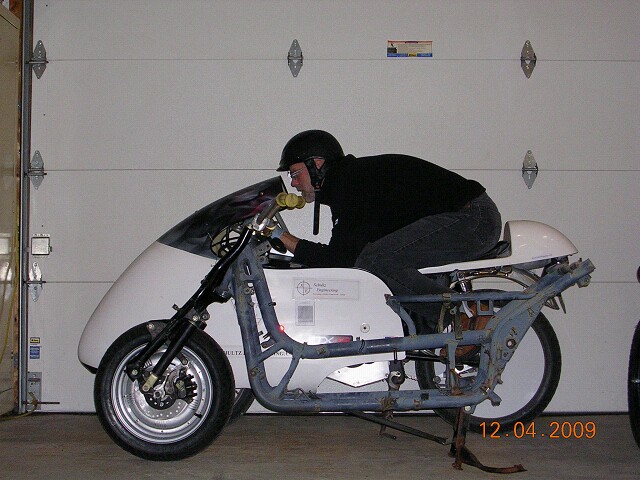 Mid-Position 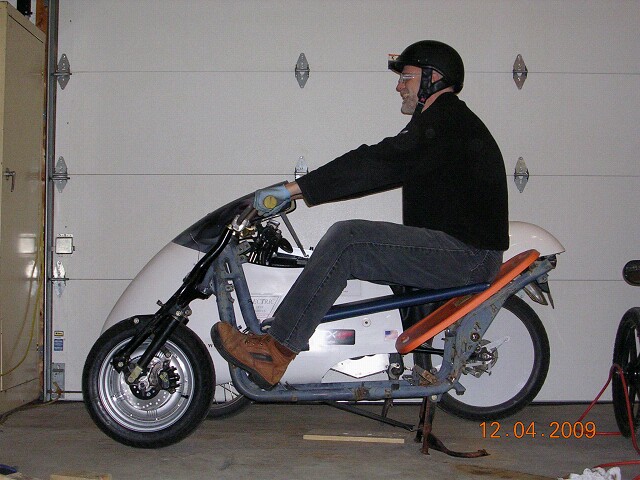 Surprisingly Comfy 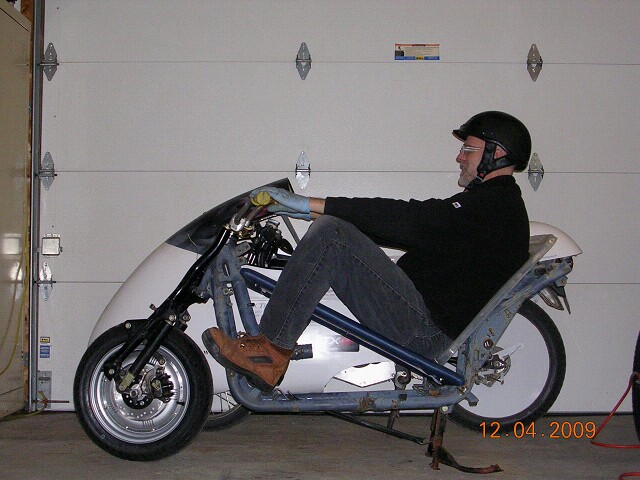 |
|
Center Braced and Lower seat mounted (December 7, 2009) 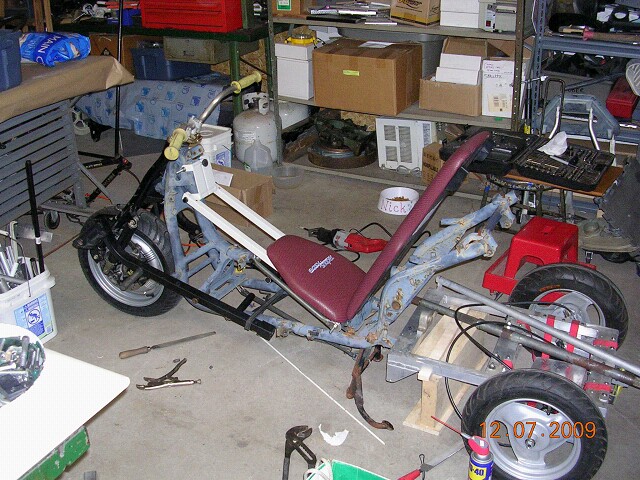 |
|
Tilting Axis Added (December 11, 2009) Long term, I want to install a pivot shaft and bearings supported with pillow blocks for the tilt axis. This shaft will have stops, tilt lock-out and tilt control features mounted on it. But, the first and most pressing question is, "what angle fore to aft should the tilt axis be?" On BMW Clever, GM Lean Machine and Honda Gyro all the pictures seem to indicate the tilt axis centerline slopes slightly upward from the rear of the vehicle and shoots over the centerline of the front wheel. But, what angle is correct? Using 2 universal joints and yokes I made a tilting axis. Two large turn-buckles in support geometry allow the tilt axis angle to be adjusted to study how this angle impacts handling. 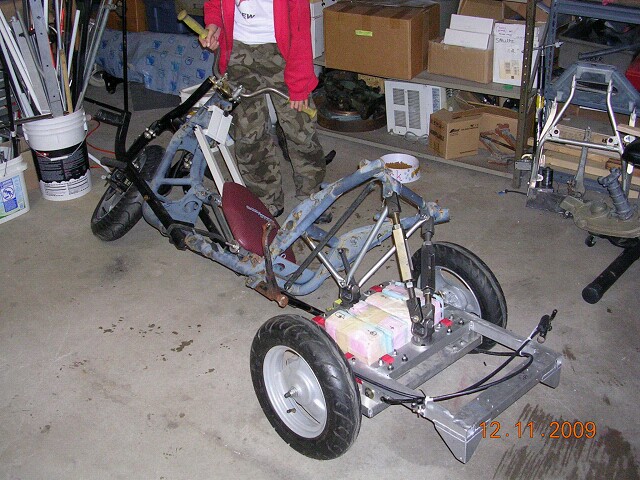 |
|
Brakes and Motor Controller (Dec. 16, 2009) Today, I tested out the Kelly motor controller and hooked up the front brakes. With the brushless motor, it's pretty cool to have reverse without having to wire in a reversing contactor.  |
|
Body Concept (Dec. 17, 2009) Finding a good body style is not easy...I could purchase and modify a really good, but small fairing like the one being sold by Craig Vetter. http://www.craigvetter.com/pages/470MPG/high%20mileage%20fairing.html  This one is not far from Vetters Rifle high mile competitition fairing (widened out by 12 inches). 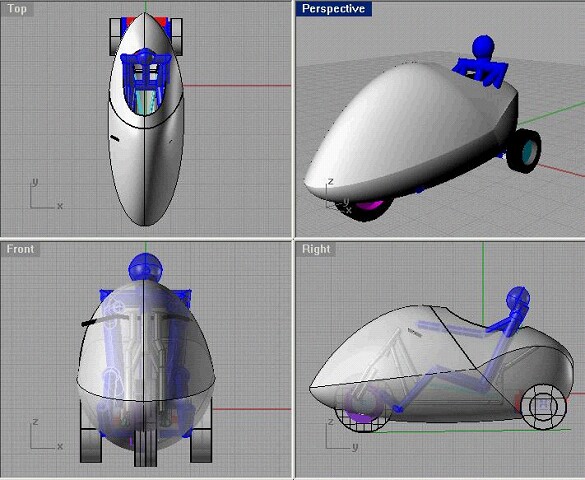 Yellow Outline in picture below shows outline of Rifle High mileage competition body. 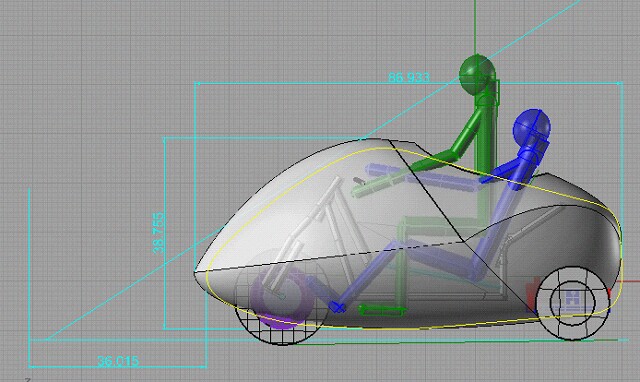 |
|
Ready to Test Drive (Dec. 21, 2009) Ready to test drive, but I'm snowed in!   |
|
FIRST Test Drive (Dec. 22, 2009) My son and I took the tilting delta trike to a parking garage in Grand Rapids to find a place without snow to its first test drive. The first test drive went awesomely smooth. Upright riding position, down riding position, tilting locked and unlocked, forward and reverse, the handling was smooth and in every way exactly like a bike - only better, because with the tilt locked in upright position, reverse was completely feet free and the steering was controllable. Even though I am running at 48 volts, the trike was peppy and climbed up the parking ramp angles no problem. The only negative thing I noticed was that, in a low speed corner, sitting in the reclined position, with the tilt working I put my foot down and nearly lost my leg as my foot caught and was pulled around. So, it is important to NOT be able to and/or need to put your feet down when riding feet forward - (this is a strong case for having foot pedals to control tilt and having a fairing to keep feet safely inside when riding with feet forward). Here is a Link to YouTube Video of First Ride. http://www.youtube.com/watch?v=FNjfmW_Sq74  Note: I am purposely zig-zagging to test the bike for stability and handling characteristics. You just cannot tell that this is a trike and not a bike when riding. |
|
More Body Concepts (Dec. 24, 2009) Here is an outline of the Vetter Freedom Machine with an RV-8 Canopy shown on it 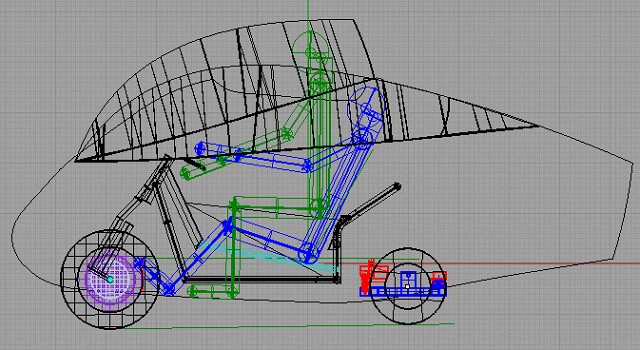 Here are concepts based on the shape of the GM Lean Machine but using an RV-8 canopy. There are three positions for the canopy and the side doors, Down, Up and Exit 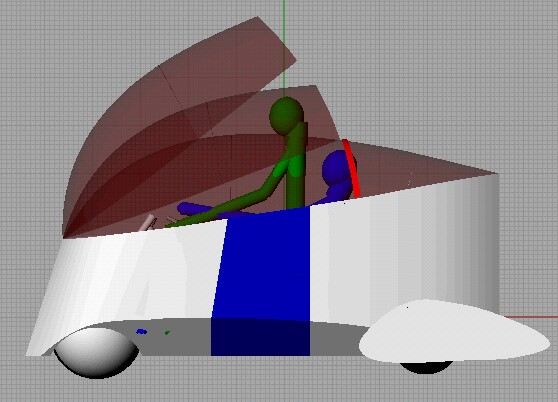 Down 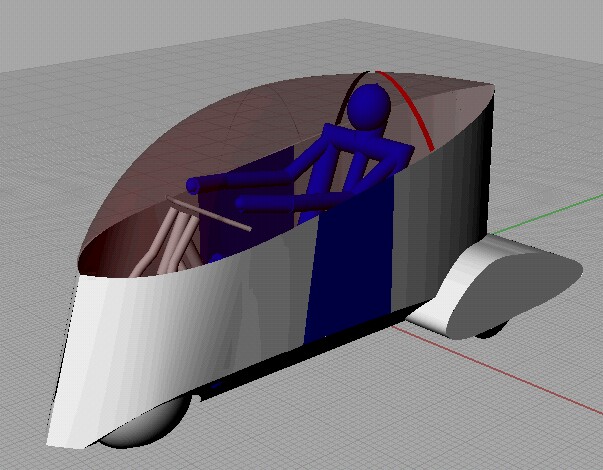 Up 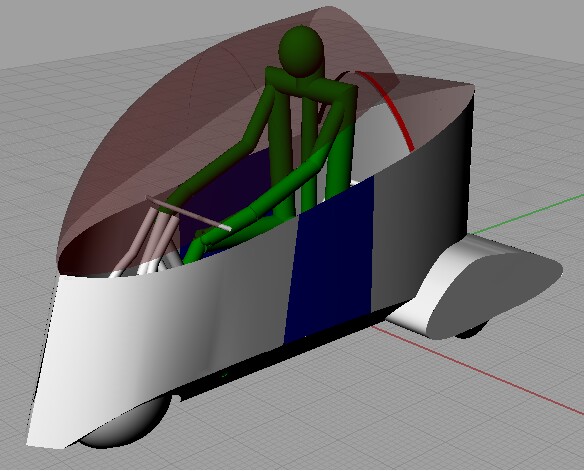 Exit 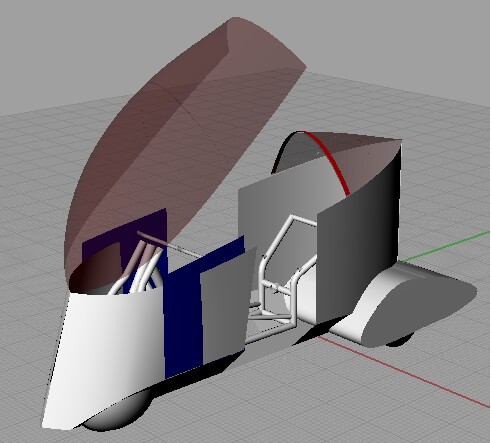 |
|
More Body Concepts (Dec. 26, 2009) BMW is thinking like me, SIMPLE, CLEVER, GINA Through the last two years of development, I have become convinced that the vehicle shape must morph as it drives down the road to provide the best shape for efficiency and safety. BMW did a concept car named GINA that had a body that could change it's shape. Polyurethane Coated Lycra provides a skin that can morph shape based on the structure pushing/supporting it from underneath. See this link... http://www.wired.com/autopia/2008/06/bmw-builds-a-ca/ http://www.wired.com/autopia/2009/10/bmw-simple-clever/ |
|
Tilting And Locking with Foot Pedals (Jan. 6, 2010) For safety (feet forward is not friendly to using feet for low speed support) and good aerodynamics, the bottom of the vehicle must be sealed. Even a small hole can increase drag by 50%. So, I'm trying to avoid any external features required to keep the vehicle upright when stopped (feet, telescoping training wheels, etc.) Also, when the vehicle does tip over on it's side with a person in it, it must be able to be uprighted from inside the vehicle. This is a challenge, because of the weight of the vehicle and the amount of torque this mass has when it rotates to the side. For tilt control, I mounted a cable drum on a 1 inch diameter shaft supported by pillow blocks. Cables run through pulleys to the front of the trike and are attached to foot-pedal-lever arms. Using 1/8" diameter cable did not work at all. The Cable was too stretchy causing poor feed-back. So, I went to 3/16" diameter cable and this made it work. I have very good tilt input with the foot pedals now, and can even hold the vehicle upright at a stop, but once it gets 10 degrees over to one side or the other at a stop, it flops over. For tilt lock-out, I mounted a band-brake on the 1 inch diameter shaft. The 4 inch diameter band brake is actuated by a hand operated parking brake lever between my legs when seated in the vehicle. The band brake is a little on the weak side, but holds the vehicle upright at stop.  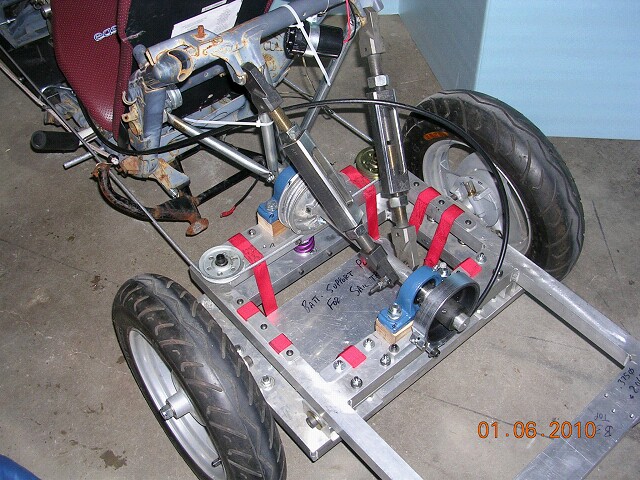 Along these lines, I studied the patent for the GM Lean machine (US Patent 4423795). The patent fully discloses the lean and lock mechanism of the lean machine. It has longer foot pedal lever arms and a very short cable going to a cable drum. It used a brake caliper to lock the vehicle upright. I think the feet are too high up in the lean machine for comfort. Next steps are to experiment with ways to 1. Reduce mass of tilting portion 2. Bring center of gravity of tilting mass very close, but just OVER the centerline of the tilt axis 3. Find a way to shift the center of gravity UNDER the tilt axis when needed to make vehicle self righting. |
|
Test Ride with Foot Pedals (Jan. 10, 2010) Video taken during the second test ride http://www.youtube.com/watch?v=yv57Hhbyyvg 
Notes from Jan. 10 test ride: 1. Can steer one handed no problems anytime
Some pictures that show size comparision next to mini-van.2. Can go no handed easily for short distances 3. Can turn around in the width of a roadway absolutely no problems 4. Foot pedals for tilt are worthless and unnecessary - the stroke is too long and they are not the intuitive direction you push to turn- they are opposite. My impression is that the foot pedal setup should be used for Left Foot brake and Right foot tilt release/lock. 5. Tilt angle of rear end seems best tilted slightly upwards but flat and tilted way up are not bad, just a little less stable at low speeds. Not unstable, but it's like balancing on the pin of a needle a little more. 6. I rode it with the tilt "lock" on accidently. The tilt lock is a band brake and doesn't actually lock the pivot, it just adds friction to the tilt axis. With the "lock" on the low speed control was LIKE A ROCK stable. Therefore, having a dampner on tilt might be a nice feature to make it more stable at low speeds. Trike loads into van with 3 inches of clearance over handlbars. 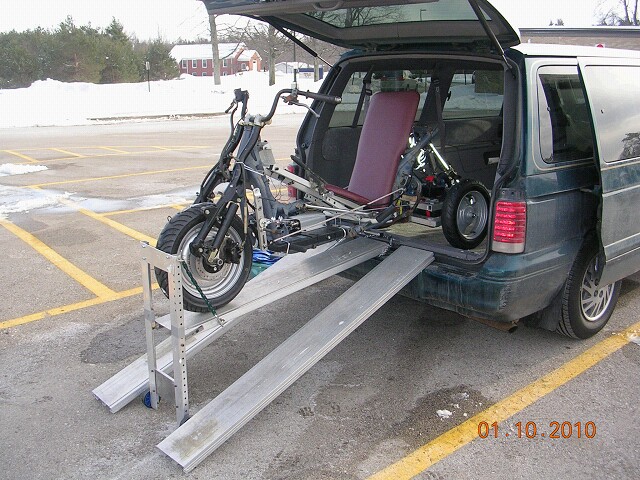 Seat in UPRIGHT position. I am at the same ride height as mini-vans. 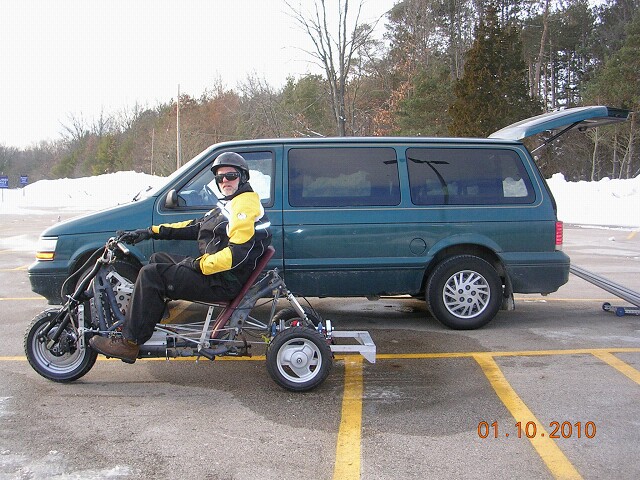 Seat in DOWN position. I am at same ride height as economy cars. 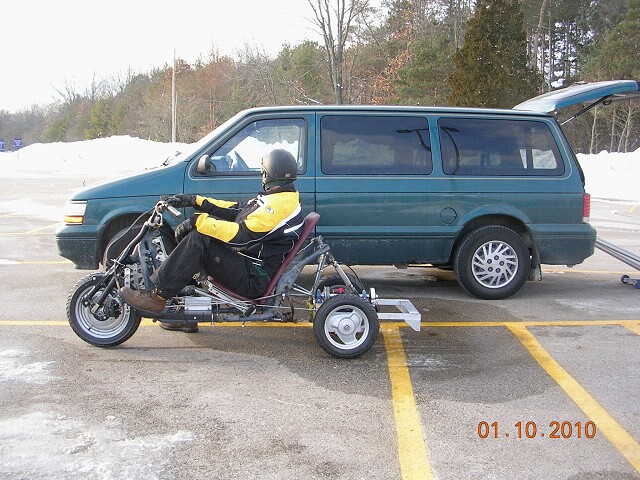 Trike is one half the min-van length and width. 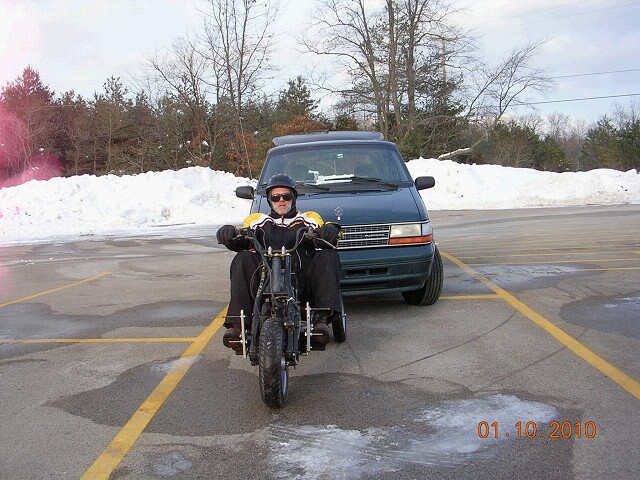 |
|
Important Tilting Trike Videos http://www.youtube.com/watch?v=JAPY7-10vhY&feature=related http://www.youtube.com/watch?v=NOJgrYkmq8A&NR=1 http://www.youtube.com/watch?v=DdhmQHexe-o&feature=related |
|
Progress (Jan. 14, 2010) Installed current meter and speedometer. Installed new batteries and Up'ed voltage to 72Volts. New max speed with front wheel up is 48mph. Installed hand controls and regenative braking circuit. Brainstorming ideas for bodies and next frame revision  |
|
Happy Birthday (Jan. 21, 2010) It was a family members birthday today, but it felt like mine. The Vetter-Rifle fairing arrived along with the second Helix fork I ordered. The UPS shipping weight for the Fairing=26 pounds. The shipping weight for the Helix Fork=28 pounds. Interesting... Sitting side by side with my Honda CB-125s with Airtech dustbin, it's easy to see the Vetter-Rifle fairing is the fairing I should have purchased originally. The fairing is perfectly sized for my little bike and of much better surface quality. Now, I have to decide what to do, put it on the trike, or put it on a bike??? 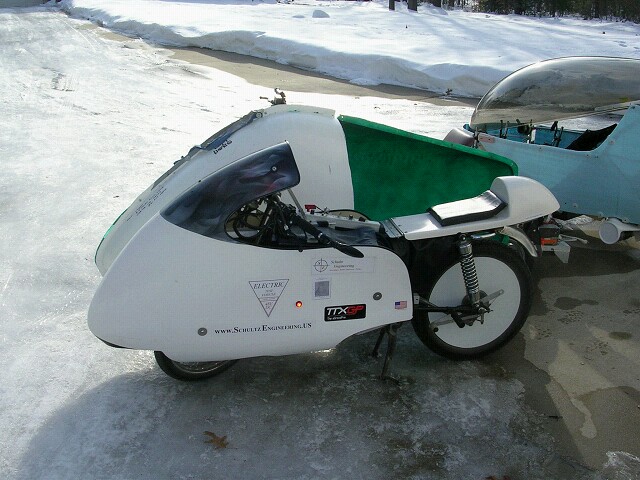 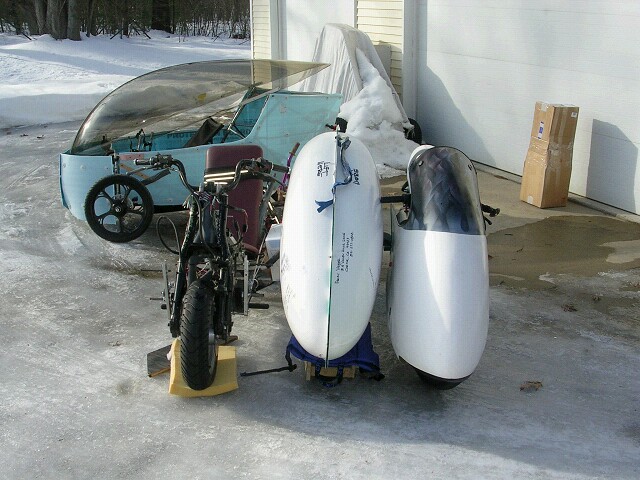  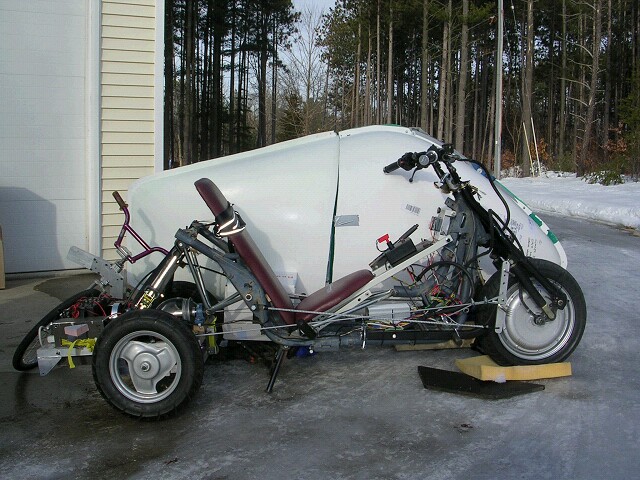 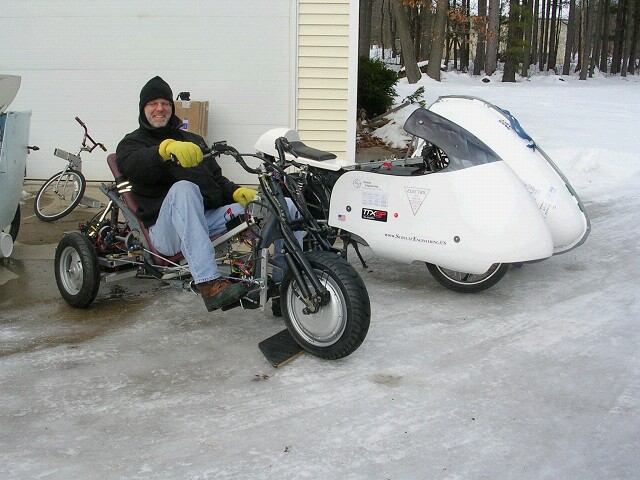 |
|
Frame Development (Jan. 29, 2010) My goal is to design a common frame that can be used for a 2-position motorcycle or trike. Here is the bike concept with the Vetter-Rifle fairing stretched and widened. 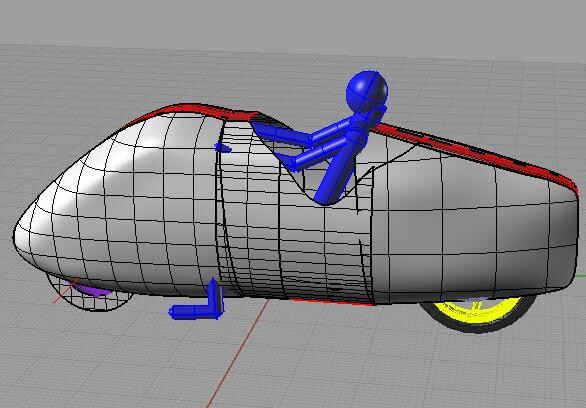 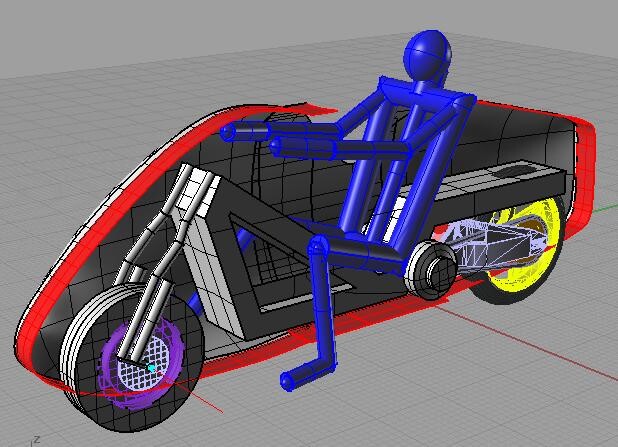 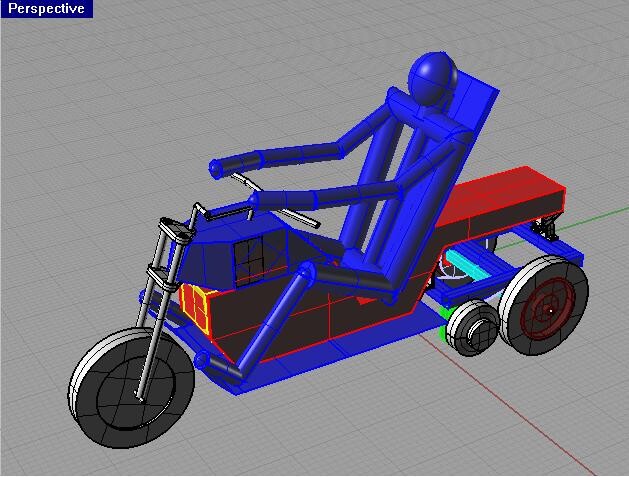 There are many advantages of the trike - one is that it can be towed with a trailer hitch. 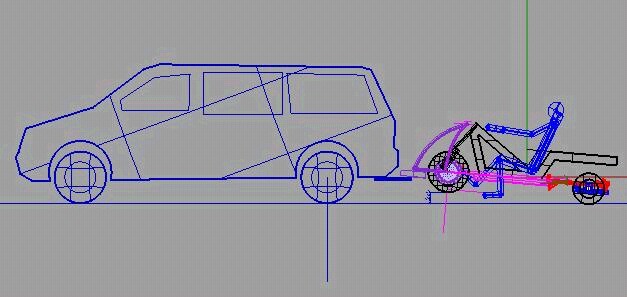 |
|
(Next Chapter - Building Tilting Trike Prototype 2) |
|
This webpage was written by Kraig D. Schultz. Copyright 2010, Schultz Engineering, LLC |